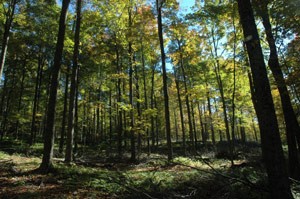
This multi-aged stand was thinned recently. Note
the straight boles on the remaining trees. That's
because the poorly formed trees were removed.
Everything we do – or don’t do – in a forest is forest management. Many of today’s foresters strive to provide excellent forest management. But what exactly does that mean? Like great art, excellent forestry is hard to define. In my view, excellent forest management provides for the needs of people while maintaining or improving the forest resource and ecosystem over the very long term.
It is an illusion that forests need people to manage them. Forests have done just fine for millennia. It is only very recently in human history that there have been enough people to significantly affect forests. With mastery of fire and the invention of axes and saws, people have changed forests in most parts of the world.
While forests don’t necessarily need people, people do need forests. The easiest part of the forest to put a monetary value on is the wood that is harvested. Assigning a value to hunting and recreation in its various forms is harder to do, though various government entities attempt to do so to justify budgets. Probably the most valuable benefits forests provide to humans, however, are hardly ever discussed in monetary terms: clean water, clean air, and flood control. These are “commons”: everyone benefits from them, but they give no direct financial return to the woodlot owner.
The simplest form of forest management is “hunting and gathering.” Humans for countless generations have sought out and taken desirable items from the forest, be they wood, other materials, or food in the form of plants, fruit, or game. If the forest resource is huge compared to what is taken, then hunting and gathering has a negligible effect on the forest. While this was the case in early human history, it is not true now. Changes in forests at all levels – in trees, wildlife, micro flora and fauna, and soils – have been caused by hunting and gathering around the world.
Highgrading, the common timber harvesting practice where only the high monetary value trees on a woodlot are harvested, is a management system in the hunt-and-gather mode. It usually gives the highest immediate financial return. Since it degrades the forest resource, however, highgrading is not good forest management. It is also poor financial management in that it greatly reduces the potential for future income from the woodlot.
So what is excellent forest management? Following are some key principles that I have derived from my 25 years of experience working as a forester in Vermont.
Excellent forest management focuses on the very long term.
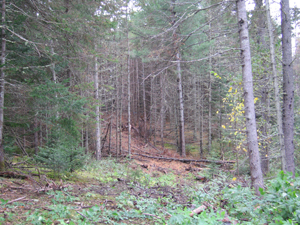
This small group selection, also know as
a patch cut, is meant to mimic a blowdown.
There are compromises and tradeoffs between near-term and long-term financial benefits, between the needs of different species of wildlife, and between what’s best for wildlife and for trees, but the focus should be on the long-term outlook. How long? Some Native American peoples consider the effects of current actions on the seventh generation from the present. Seven generations of people is perhaps 150 to 200 years, which is less than the life span of many trees. This highlights a basic problem in forestry: how can we maintain excellent forest management practices over such a long time period, given the many different owners a woodlot is likely to have?
Excellent forest management requires a very long-term perspective because forest ecosystems are rich and complex and develop slowly, and trees can be very long-lived organisms. People’s ignorance, greed, and, at times, financial emergencies can get in the way of good, long-term management. I’ve seen very few woodlots that have had more than 50 years of exemplary management. The rewards of excellent forest management often are obvious within 10 years, however, and make the effort worthwhile.
Excellent forest management is by nature conservative.
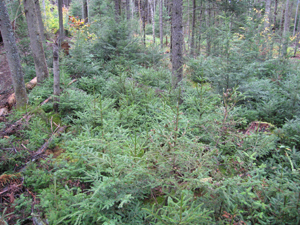
This dense carpet of regeneration sprang up after a
small blowdown.
We really know very little about forest organisms and their interactions, so practicing forestry can be a humbling experience. Often, trees don’t react the way we expect them to: regeneration cuttings sometimes fail or give a preponderance of undesired or unexpected species; sometimes the growth rate of the remaining trees doesn’t increase following a thinning; and unforeseen insect or disease attacks occur.
Ecologists have documented a vast web of interconnections between the organisms in a forest and are just beginning to decipher what goes on in that web. This is especially true in the soil, where countless organisms remain to be discovered, named, and studied. Recent research, for instance, has revealed that rotting logs are essential habitat for salamanders. If we keep the forest floor “clean” by removing all wood material larger than, say, 4 inches in diameter, we will have a dearth of salamanders. What effects might this have on their prey species, and the prey of those species, and ultimately on the trees we want to grow? No one knows.
The cardinal ideas of conservative forestry are: maintain or increase species diversity; protect soils; protect water quality; leave some large woody material on the forest floor; and leave some dead and dying trees standing in the forest when they don’t present an unreasonable safety hazard.
While there is much that we don’t know about forests, good forest managers learn all they can and apply this knowledge to make the best management decisions possible. To be successful, managers need to be well aware of life spans of different tree species, how they respond in different situations, what germination conditions are needed by seeds of different species, and much more.
In excellent forest management, forest managers recognize and work with the changes that occur in our forests.
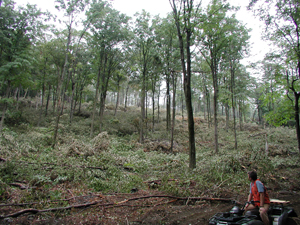
This shelterwood cut took place in a stand that had previously
been highgraded. The striped maple and beech in the understory
were removed at the same time that 50 percent of the overstory
was removed. The overstory is largely yellow birch, and the forester
hopes to get yellow birch and white ash regeneration.
Forests are constantly changing. The day-to-day and year-to-year changes in forests are often hard to discern, yet the forest is continually changing. There are seasonal changes, trees are growing, and trees are dying and decaying. Animal and insect populations change.
Over a longer time period, predominant tree species change, as do wildlife species in response to habitat changes. The term “succession” is often used to describe these gradual changes. Some people who believe the forest should “stay the same” fail to comprehend that change is inevitable.
That change can also be dramatic, even cataclysmic, when it is brought on by large-scale disturbances. Examples include hurricanes and other windstorms; ice storms and heavy, wet snows; fire; volcanoes; floods and droughts; and insect and disease outbreaks. This past year’s hurricane season, for instance, has laid flat vast areas of forest in the Southeast.
Imported insects and diseases have changed the species composition of our eastern forests. Chestnut has been virtually eliminated, and healthy elms are now rather rare, thanks to the Dutch elm disease. The gypsy moth defoliates – and stresses – huge areas each year. The hemlock woolly adelgid, an insect that kills hemlocks, is spreading. The Asian long horned beetle and emerald ash borer may spell the demise of maples and ashes, respectively, if the current efforts to contain infestations fail.
Plans for forest management need to recognize the compositional changes that tend to occur over time and, in areas where fire or storm damage is common, plan for these events. Woodlots need to be inspected regularly (at least annually) for unexpected changes, and plans adjusted as the need becomes known.
Planning is a critical part of excellent forest management.
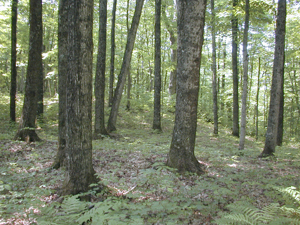
This nice stand of sugar maples got its start with the hurricane
of 1938. These trees were saplings in the understory when
the canopy of mature trees was blown down.
The first step is to decide what the long-term objectives are. Then a management plan can be formulated to work toward those objectives. It is essential that forest management plans be written (not just thought about) and tied in with a map of the woodlot.
I find that 10-year cycles work well for management plans. A good plan describes the current status of each forest stand and lays out what actions (if any) should be taken in the next 10 years. After 10 years, the forest stands are reassessed, and plans are made for actions to be taken during the ensuing 10 years. Occasionally, a major disturbance, such as a storm, fire, or insect damage, will necessitate updating plans between the 10-year intervals. Updates also need to be in writing and become a new starting point for 10-year cycles.
Often there are multiple objectives for a woodlot. Sometimes these different uses are completely compatible. For instance, hiking (and in northern climes, cross-country skiing and snow-shoeing) and wildlife watching can be 100 percent compatible with the goal of growing large, high-quality trees for sawlogs and veneer. Other times, different uses are in conflict. As an example, maintaining a deer wintering yard can be a very important component of encouraging a large deer population, but a large deer population will make it virtually impossible to regenerate many tree species within a large area surrounding the deeryard. Resolving such conflicts requires prioritizing uses, which is often not easy.
In excellent forest management, trees are selected to be killed in a manner that mimics nature.
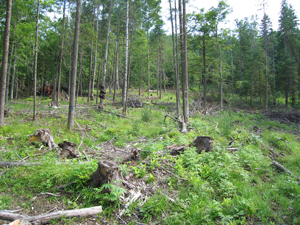
This diameter-limit cut removed all trees whose diameters were
10 inches or more. This cutting system is not good silviculture
and results in a progressively less valuable forest.
Killing trees is the primary tool of forest management here in the Northeast. The many different kinds of cutting used to manage the trees in forests – highgrading, diameter limit cutting, thinning, timber stand improvement, commercial clear cutting, silvicultural clear cutting, crop tree management, individual tree selection, group selection, shelterwood, seed tree, overstory removal – are really descriptions of which trees to kill and which, if any, to leave for more growth or to influence the next generation of trees.
Mimicking natural processes complements forces already at work in the forest. Thinning mimics the natural process where weaker trees die, giving more room and resources to the stronger individuals of the same age. Individual tree selection mimics the natural death of scattered trees, whether because of age, lightning strikes, disease, windthrow, or other causes. Shelterwood cuts and subsequent overstory removals should mimic a successional stage where pioneer species in an overstory are dying, making room for mid- and late-successional species to grow and take over the forest canopy. Silvicultural clearcuts and group selections should be designed to mimic a small-scale cataclysmic event, where the objective is to promote regeneration of desired species.
The objectives in applying these management strategies are to speed up natural processes and determine which trees will continue to grow (species, vigor, and tree form are the usual criteria) or are regenerated. A manager can select for more valuable or otherwise desirable species and encourage them to grow faster. Vigorously growing trees are better able to deal with attacks by insects and disease and to withstand the vagaries of weather. In addition, faster growth decreases the time it takes for trees to reach marketable size, increasing financial returns.
When maximizing long-term financial returns is the goal, the key to excellent forest management is to manage for log quality and log size and to time harvests of high-value trees with upswings in the market.
Maximizing very long term (intergenerational) financial returns can be consistent with excellent forestry; maximizing near-term financial returns is not. One should recognize that it does not make sense to even try to manage some forest stands for a financial return. Examples include stands where major, stand-destroying disruptions can be expected fairly regularly and those where poor soils, exposure, drought, or other conditions result in poor growth potential. Such stands should be managed by doing nothing (letting nature take its course) or possibly managed for some other value, such as a particular species of wildlife.
Log quality is important because high-quality logs are worth more – often far more – than low-quality logs of the same size and species. What determines quality varies somewhat with species and markets. The factors we have most control over are knots and wounds. We can control knot presence and size through stand density and pruning. It is essential to avoid wounding the trunks of trees because the effects on log quality are profound.
Tree value per unit volume jumps at certain thresholds for most markets. Larger logs can be used for more valuable products and they are less expensive to harvest and process per unit volume. Jumps generally occur when trees first become large enough to be worth economically harvesting for firewood or pulpwood, when they reach minimum sawlog size, when they reach moderate sawlog size, and when they reach large sawlog size.
Prices paid for standing timber vary over time. Factors include the number of housing starts, changes in local markets, and the national and international economy. Also, different species go in and out of favor. Right now, cherry and sugar maple are particularly desired, so their prices are high, and good forest management plans should be adjusted to take this into account.
So how does excellent forest management play out on the ground? When planning management activities for a forest stand or marking a stand for cutting, my focus is on the long-term health and productivity of the forest ecosystem, tempered with a dose of financial reality. The rules of thumb I use are:
Biological vs. Financial Maturity
A tree is considered to be biologically mature (from a harvesting perspective) when it reaches old age and just starts to decline. At this point, it grows very slowly and becomes more susceptible to infections and decay.
A tree is considered to be financially mature when its expected increase in value over the next year (in increased volume and value per unit volume) is less than the increase in value if the tree is harvested and the money received for it is invested.
There is some logic to harvesting trees when they are financially mature, but only if: the value of the land does not decrease as a result of cutting the trees; no costs are incurred in establishing and growing the next generation of trees; and no “threshold” increases in value per unit volume are expected in the future because the trees become large enough to yield more valuable products. All three of these conditions are not usually met, so blindly harvesting trees when they are financially mature is shortsighted.
This is not to suggest that trees should only be harvested when they are biologically mature. Killing some trees to give others more resources to maintain or increase their growth rates often necessitates cutting trees before they are biologically mature. Trees that have been damaged (either naturally from weather events, animals, insects, or disease, or mechanically, from harvesting nearby trees) may lose value rapidly from decay and thus should often be harvested even though they may be able to live for many more decades. For some products, there is an upper log-size limit, governed by the maximum capacities of the potential buyers’ processing equipment, above which trees will lose value.

